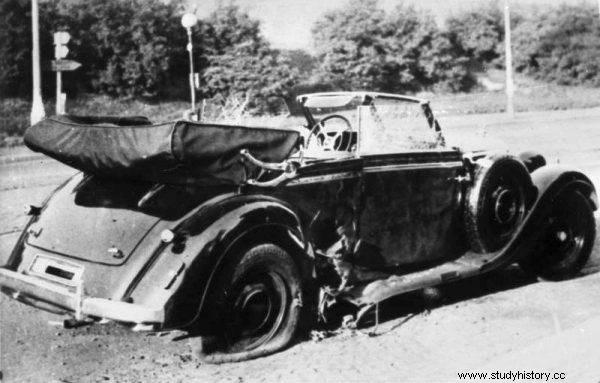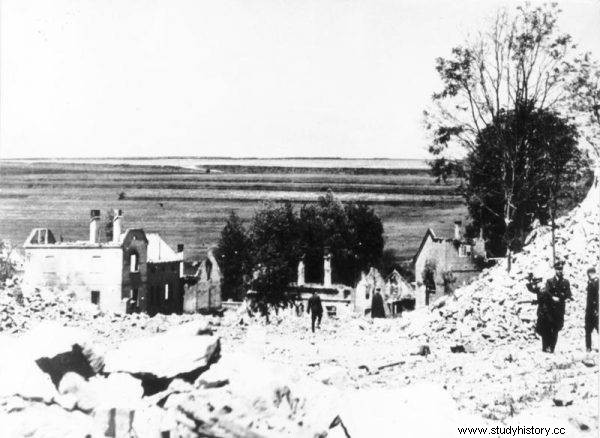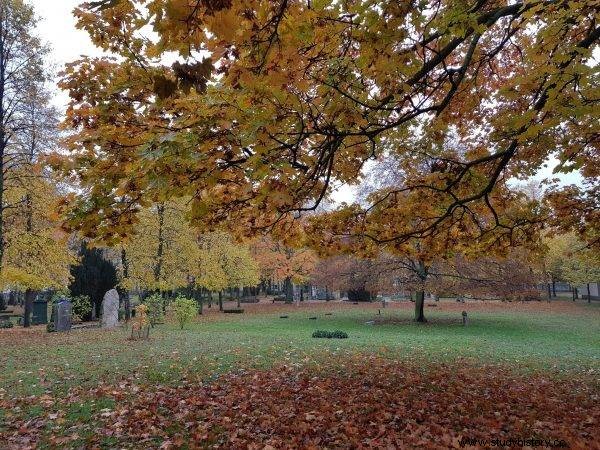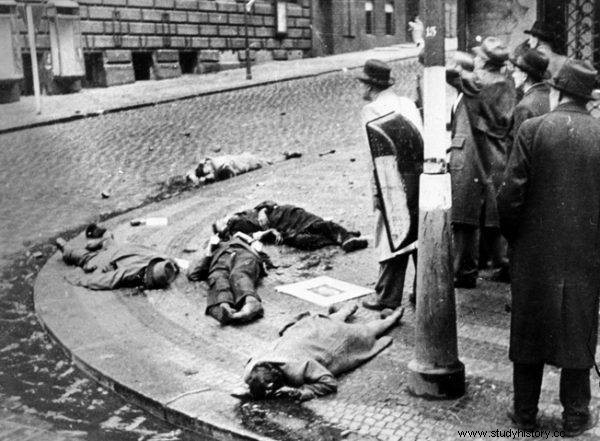Men and boys over 15 were shot, women were sent to the Ravensbrück concentration camp, and younger children were gassed in the camp in Chełmno on the Ner. Two villages:Lidice and Lezaki were razed to the ground. For many months, the Germans took their vengeance on the Czech Republic for the attack on Reinhard Heydrich.
On May 27, 1942, the Czech underground carried out an attack on SS-Obergruppenführer Reinhard Heydrich, the occupying protector of Bohemia and Moravia, in Prague. A paratrooper trained in England - Jan Kubis - threw a briefcase with a strong explosive charge (a modified anti-tank grenade) under the car carrying a dignitary considered the third - after Hitler and Himmler - personality of the authorities of the Third Reich. Heydrich was seriously injured, he had, inter alia, injured leg, punctured spleen, damaged lung, diaphragm and pancreas. The wounded man was taken to hospital, where he died on June 4 as a result of an infection.
We wrote more about the reasons for the attack on this soulless SS man and the course of the operation code-named "Antropoid" in the article "Fawn beast. All the crimes of Reinhard Heydrich. ” Let us only recall that Heydrich was the creator of the program of the "Final Solution of the Jewish Question", and was responsible for the persecution, displacement, arrest, torture and economic exploitation of thousands of Czechs. Using his unlimited power, with a sense of absolute impunity, he carried out activities aimed at the complete extermination of the Jewish community living in Bohemia and Moravia.
Heydrich's funeral took place on June 9, 1942 in the German "national pantheon" at the Invalids Cemetery in Berlin. It was the largest mourning ceremony in the history of the Third Reich with the participation of the highest Nazi authorities. The funeral procession passed through the entire city. Speakers over the coffin included:Hermann Goering, field marshals Gerd von Rundstedt and Ernst Busch, the head of the German Labor Front, Robert Ley, and of course Himmler and Goebbels.

Heydrich's car after the attack
Hitler demanded bloody revenge, and soon after the funeral, the vengeance began. It was planned and carried out meticulously by Karl Hermann Frank, the commander of the SS and police in the Czech Republic, who was counting on the position of a new protector. To begin with, to show his firmness and to please the Führer, he ordered the shooting of 100 hostages and prisoners who were in German hands. Among them was General Alois Elias, the pre-war minister and prime minister of the Czech government. In retrospect, this execution was only a prelude to a bloody slaughter. Subsequent, more and more brutal acts of terror were to intimidate the Czechs and paralyze their will to resist, and above all, persuade them to hand over the assassins.
Destruction of Lidice and Lezaks
When the Germans obtained unconfirmed and untrue information that the assassins were hiding in the village of Lidice, Hitler ordered its complete destruction. An order was sent from Berlin to Prague:
1. Shoot all adult men. 2. Transport all women to concentration camps. 3. Select children who can be Germanized and hand them over to SS families in the Reich. Raise the rest of the children in a different way . 4. Burn the village and raze it to the ground (...)
In 1942, Lidice had 102 houses inhabited by a total of 503 people. The Germans surrounded the town on June 9 in the evening, and the next morning, pacification units consisting of Gestapo, SD, Schutzpolizei and SIPO officers under the command of SS officers entered the village. All the men were driven out of their homes and taken to the large farm of the Horak family. The walls of one of the basements were covered with mattresses from the beds (so that the missiles would not ricochet) and there were taken prisoners in groups of 5 or 10 people. After the war, one of the Gestapo officers who participated in the pacification testified:
(...) after the volley, the non-commissioned officer, who was standing next to the commanding officer, approached the dead and shot each of them again with a pistol in the head. The dead bodies were left as they had fallen to the ground. More men who came to the wall of death had to stand in front of them. The firing squad took a step backwards and everything was repeated over and over again. Nobody's hands were bound, nobody was blindfolded.
180 men aged 15 to 83 were shot in this way. The last of those murdered was the mayor Frantisek Hejma, who was ordered to confirm the identity of the victims. One of the women who survived the pacification recalled:
All eyes had one question:What are they going to do with us? (...) How difficult it was to leave your home! All the windows were open, and although there was a strict blackout command, there was light everywhere. Various items were thrown out in front of the houses. Sewing machines, radios, bicycles, there were clothes and food on the windows (…). Our men were standing on the square of Horak's estate. It was there that we saw them for the last time.

Lidice was razed to the ground
Women and children were taken from Lidice to Kladno, after which the little ones were taken from their mothers. 198 women were sent to the Ravensbrück concentration camp. Children were tested for "Aryanness". A small group was deemed fit for Germanization and was sent to the centers of the Lebensborn organization. They hit, among others to Puszczykowo near Poznań, where, after depriving them of their identity, they were sent to SS families who had not raised children.
Most of the children (without "Aryan" appearance) were sent to the Kulmhof extermination camp in Chełmno on the Ner. On July 2, 1942 83 children from Lidice were murdered there with gas from the exhaust pipe put into the cargo box of a delivery truck . This method was used in Chełmno to murder thousands of Jews, including from the ghetto in Łódź and the entire Warthegau.
In Lidice, the Germans confiscated all valuables, including livestock and agricultural machinery, and then demolished (burned or blown up) houses, razed the cemetery to the ground, felled trees, filled the pond with rubble, and even partially moved the streambed so that the maps would not be removed in the future. indicated the places where the village existed. They even took care of removing the name Lidice from the administrative registers. In the next stage of the execution, on June 16, they shot 26 inhabitants at the Kobylisy shooting range in Prague, who were not in Lidice during the pacification.
On June 24, after discovering the traces of an underground transmitting and receiving radio station, a similar fate befell the smaller village of Lezaki. It was surrounded and pacified by a 500-strong unit of SS soldiers, field gendarmerie and order police. 75 adult inhabitants of the village were shot, the houses were first set on fire and then demolished. 13 children from the village of Lezaky were transferred to Germanization.
Betrayal for money
The destruction of Lidice did not lead the Germans to the trail of the attackers, so in Prague and the whole Czech Republic, feverish searches for the perpetrators and their associates continued. The Gestapo and the SS raged and threatened with further repression.
Probably the conspirators could not have been found had it not been for the betrayal. Karel Curda, who did not participate in the attack, but also trained in England as a paratrooper, came forward tempted by the high reward and started pointing out people who might be related to the attack. He was supposed to get a million marks for that.
Curda knew the names of only a few conspirators and a few addresses, but the arrests and brutal interrogations of the people he indicated resulted in the mishaps of more . On June 17, the Germans entered the apartment of the Moravc family indicated by Curda. The inmates were forced to stand in the corridor while the Gestapo searched the rooms. Maria Moravec was allowed to go to the toilet, where she bit the cyanide capsule, committing suicide.

Dilapidated part of the Invalids Cemetery in Berlin where Heydrich is buried.
Alois Moravec and his 17-year-old son Vlastimil pseud. Ata were taken to Petschek Palace where they were tortured. "Ata" wouldn't say anything, but then investigators showed him the mother's severed head in a formalin jar and they said his father would be next. Then Vlastimil broke down and indicated several addresses. He was executed in the Mauthausen concentration camp on October 24, 1942, along with his father, his fiancée, her mother and brother.
This is how the Gestapo finally found Heydrich's murderers who hid in the basement of the Cathedral of Saints Cyril and Methodius, the Prague Orthodox cathedral. On June 18, armed to the teeth, SS men surrounded the church, and after a seven-hour fight, all the assassins and the conspirators who supported them died or committed suicide. For helping to hide the soldiers of the underground, the parish priest and bishop Matej Pavlik and many priests of the cathedral parish were shot, and the Orthodox Church of the Czech Republic and Slovakia was banned. All Orthodox churches have been closed.
20,000 for one
As a result of an extensive investigation and torture, another 230 people related to the bombers were arrested and also shot. In the weeks that followed, some 13,000 people were arrested, of whom over 5,000 were murdered. About 4,000 arrested, mostly random people who had no connection with the coup or the resistance movement, were sent to concentration camps. In total, at least 20,000 Czechs were subjected to repression, but this figure seems understated.
Unparalleled terror, murders and arrests raging throughout the country for several months almost completely shattered the Czech underground, and the society became discouraged from any form of resistance and even more so to conduct military actions. It was only in the last year of the war that the Czechs decided to raise their hand against the Germans again, initiating the Prague Uprising lasting from 5 to 9 May.

It was only in the last year of the war that the Czechs decided to raise their hand against the Germans again, initiating the Prague Uprising lasting from 5 to 9 May.
The Germans, who were fond of mysticism and occult symbolism during the Nazi period, gave the name "Einsatz Reinhardt" to the great extermination of Jews from the General Government and the Białystok region in 1942 and 1943. It was a form of a "blood sacrifice" and a tribute to Heydrich who was killed in Prague. About 1.8 million Jews died in the "Operation Reinhardt".
The tombstone of the "fawn beast" at the Invalids Cemetery in Berlin was liquidated, but his remains remain there to this day - in an unmarked grave, the location of which is not given by the administration.
The village of Lidice was rebuilt after the war, close to the crime scene. In the area of the former Lidice, there is a Memorial Center with many monuments, symbolic sculptures and a beautiful rose park with flowers sent from various countries around the world.
